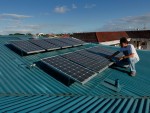 From rubber dinghies to television sets: the emissions of greenhouse gases in countries like China are to a significant extent caused by the production of goods that are exported to Germany or the United States. But this doesn’t necessarily mean that Western countries have relocated their emission-intensive industries, and hence, escape regulation for climate protection. This is shown in a study appearing in Nature Climate Change this week.
From rubber dinghies to television sets: the emissions of greenhouse gases in countries like China are to a significant extent caused by the production of goods that are exported to Germany or the United States. But this doesn’t necessarily mean that Western countries have relocated their emission-intensive industries, and hence, escape regulation for climate protection. This is shown in a study appearing in Nature Climate Change this week.
Instead, researchers were able to pin down a number of factors explaining the pronounced imbalances between emission importers and exporters, the US current account deficit being one of them. Their conclusion: interventions in world trade, like CO2 tariffs, would probably have only a small impact on global emissions.
Steadily growing world trade leads – as earlier research has shown – to a substantial transfer of CO2 from one country to another. The traded goods effectively contain the greenhouse gas, as it originates from the energy used during their production.
“Typically, in the West, we import goods whose production causes a lot of greenhouse gas emissions in poorer countries – and it is a contested question to which countries these emissions should be attributed,” explains Michael Jakob, from the Potsdam Institute for Climate Impact Research (PIK), one of the authors. This is a delicate issue, because many Western countries have ambitious targets for emissions reductions. Simply transferring emission-intensive industries to third countries in order to achieve these goals would not serve climate protection – and might even damage the economy.
Almost Half of the CO2 Transfers into the U.S. are Caused by American Trade Deficit
“For the first time, we have now broken down the known emission transfers into their components,” Jakob says. The economic analysis is based on an evaluation of estimates that were determined by other researchers in earlier studies. “We can show that of the CO2 flowing into the U.S. in form of imported goods, almost 50 per cent are due to the American trade deficit alone,” Jakob explains.
The US emits less CO2 in the production of its exports than is contained in its imports, simply because it imports more than it exports. “And only about 20 per cent of CO2 transfers from China into the U.S. can be traced back to the fact that China is in effect relatively more specialized in the production of dirty goods,” Jakob says. But this is the only driver of emission transfers on which the currently controversially discussed climate tariffs could take effect.
Without world trade, the emission of greenhouse gases in countries like China could potentially be even higher than today, according to the study. Western countries often export goods like machines that need a lot of energy in the production process. Usually, this energy stems from comparatively clean production processes.
On the other hand, China produces a lot of export goods like toys, whose production needs relatively little energy, but stems from emission-intensive coal power plants. If China with its fossil energy mix had to produce more energy-intensive goods itself instead of importing them, emissions would increase. “In the end, interventions in world trade could do more harm than good,” says co-author Robert Marschinski from PIK and Technische Universität Berlin.
“The Crucial Question is How Clean or How Dirty National Energy Production is in Each Case”
“Crucial for CO2 transfers is not only world trade, but also the question of how clean or dirty national energy production is in each case,” Marschinski emphasizes. To look only at CO2 transfers could be misleading. If, for instance, the European Union were to adopt new low emission production methods, its net imports of CO2 could increase even though there is no relocation of production.
“To really justify trade-policy interventions like the much discussed CO2 tariffs, further analysis would be needed – the observed CO2 transfers alone are not enough as a basis,” Marschinski explains. “Such measures cannot replace what it really takes: more international cooperation.”
Binding global climate targets could give incentives for investors to promote low-emission technologies. Innovations in efficiency could get financial support, and regional emission trading systems could be linked with each other, Marschinski says. “All this could help to achieve climate protection targets in an economically reasonable way.”
Source: PIK.














